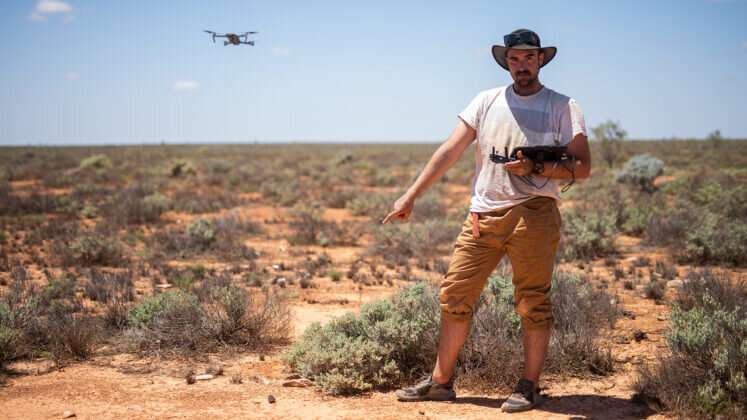Drones and artificial intelligence aid hunt for fallen meteorite in outback Western Australia

Curtin researchers have recovered a freshly fallen meteorite after pinpointing its exact location on the vast Nullarbor Plain in Western Australia, with a new technique that uses a drone to collect footage of the landscape that is then scanned using artificial intelligence.
Lead researcher, graduate student Seamus Anderson from Curtin's Space Science and Technology Centre (SSTC), said the find at Kybo Station late last year was a successful demonstration of the new method, which had the potential to greatly increase the number of recovered meteorites, particularly those observed as they fall through the atmosphere.
"A camera-fitted drone flies over and collects images of the fall zone, which are transferred to our field computer where an algorithm scans each image for meteorites and features that resemble them," Mr. Anderson said.
"Although our algorithm was 'trained' on data collected from past meteorite searches, we brought with us previously recovered meteorites and imaged them on the ground at the fall site, to create local data with which to further train the algorithm.
"Meteorite searches usually involve a group of people walking over a large predicted impact area but our new method requires only about one tenth the amount of labor and time and has a much higher likely success rate, which is evident in the fact we located and recovered the meteorite within four days of being on site at Kybo Station."
Mr. Anderson said such meteorites, which are tracked by the Desert Fireball Network (DFN), were special because they gave a geologic sample of the particular region of the solar system from which they originated, contributing to an overall understanding of the geology of the solar system.
"New solutions such as our drone technique help make investments in space science and the study of meteorites more cost-effective and impactful," Mr. Anderson said.
"Beyond increasing our understanding of the solar system, the study of meteorites is useful for many reasons. For example, meteorites often contain a higher concentration of rare and valuable elements such as cobalt, which is crucial to the construction of modern batteries.
"Also, by gaining a better understanding of how extraterrestrial material is distributed throughout the solar system, we may one day mine asteroids for precious resources, instead of scrounging for the finite amounts of them on Earth and perhaps harming precious ecosystems in the process.
"Other potential applications for our new approach using drones and artificial intelligence include wildlife management and conservation, as our model could be easily retrained to detect objects other than meteorites, such as plants and animals."
More information: Seamus L. Anderson et al, Successful Recovery of an Observed Meteorite Fall Using Drones and Machine Learning (2022). arXiv:2203.01466 [astro-ph.EP] arxiv.org/abs/2203.01466
Provided by Curtin University





















